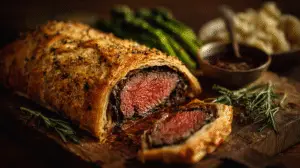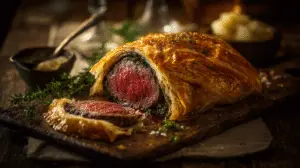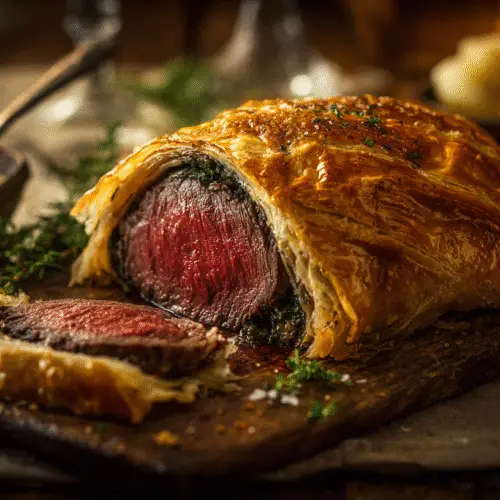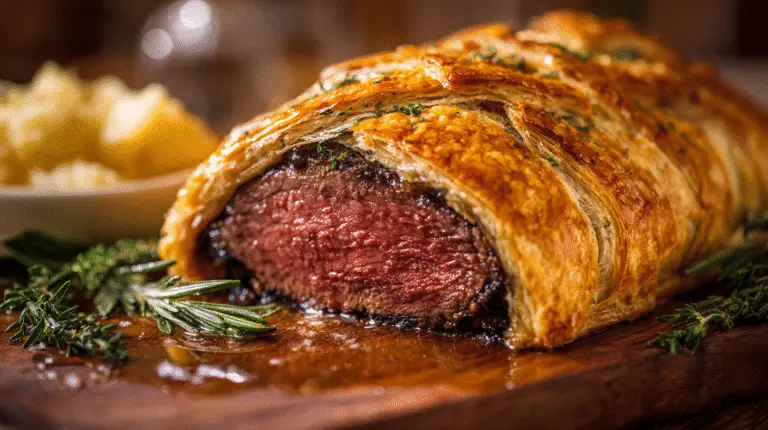There are meals, and then there is Beef Wellington. It is, without question, the ultimate culinary showstopper. The kind of dish that elicits gasps of admiration when you bring it to the table and a moment of reverent silence after the first bite. It has a reputation for being notoriously difficult, a recipe reserved for professional chefs. Today, I’m here to demystify this masterpiece and show you that with a little patience and a clear plan, you can absolutely conquer it in your own kitchen.
This is my complete Classic Beef Wellington Recipe – Step by Step Guide. We are going to create a true work of art: a perfectly cooked, rosy-pink, and unbelievably tender center-cut beef tenderloin, encased in a deeply savory mushroom duxelles and a layer of salty prosciutto, all wrapped up in a golden, flaky, buttery puff pastry crust that shatters at the touch of a fork.
This is not a simple weeknight dinner; this is a rewarding weekend project, a celebration meal, the perfect centerpiece for a holiday like Christmas (Weihnachten) or a special birthday here in Cologne. Follow me, step by step, and I promise you will create a meal that you and your loved ones will never forget.

Conquering the Ultimate Culinary Showstopper
The Beef Wellington is a dish of pure luxury with a storied history. At its heart, it’s a celebration of the finest cut of beef—the tenderloin—and the transformative power of classic French techniques. It’s the kind of dish that feels like a special occasion in and of itself.
My goal with this guide is to break down what seems like an intimidating process into a series of simple, manageable stages. The key to a successful Wellington is not about being a world-class chef; it’s about preparation, patience, and chilling. Each layer serves a purpose: the mustard adds a tangy kick, the mushroom duxelles provides an earthy depth, the prosciutto seasons the beef and creates a crucial moisture barrier, and the puff pastry provides that glorious, golden, crunchy exterior. When it all comes together, it’s culinary magic.
Why This Recipe is Worth the Effort:
- An Unforgettable “Wow” Moment: Slicing into a perfect Beef Wellington at the table is a moment of pure culinary theatre. It is the definition of a showstopper.
- Incredible Combination of Flavors & Textures: You get the tender, juicy beef, the savory, earthy mushrooms, the salty prosciutto, and the crisp, buttery pastry all in one perfect bite.
- A Detailed, Foolproof Guide: I will hold your hand through every single stage, with clear instructions and crucial tips to ensure your success and prevent the dreaded “soggy bottom.”
- The Perfect Make-Ahead Showstopper: The beauty of this recipe is that all the main prep can be done the day before, leaving you with just the final bake on the day of your event.
Ingredients & Equipment
For the Beef and Duxelles:
- Center-Cut Beef Tenderloin (Rinderfilet im Mittelstück): about 1 kg (2-2.5 lbs), trimmed.
- Olive Oil: 2 tablespoons.
- English or Dijon Mustard: 2 tablespoons.
- Cremini/Chestnut Mushrooms: 450g (1 lb).
- Shallots: 2, finely chopped.
- Fresh Thyme: 1 tablespoon, leaves only.
- Unsalted Butter: 1 tablespoon.
- Dry White Wine: 60 ml (¼ cup).
- Prosciutto (or Parmaschinken): 12 thin slices.
For Assembly and Baking:
- All-Butter Puff Pastry (Blätterteig): 1 large sheet (about 400-500g).
- All-Purpose Flour: For dusting.
- Egg Yolks: 2, beaten with 1 tablespoon of heavy cream for the egg wash.
- Coarse Sea Salt: For sprinkling on top.
Essential Equipment:
- A large skillet.
- A food processor.
- Plastic wrap.
- A sharp knife.
- A pastry brush.
- A large baking sheet lined with parchment paper.
- An instant-read meat thermometer. This is not optional; it is the key to success.

Time Estimates
- Active Prep Time: 1 hour
- Chilling Time: At least 1 hour (can be done overnight)
- Cook Time: 20-25 minutes
- Total Time: Approximately 2.5 – 3 hours (with a lot of inactive chilling time)
Step-by-Step Instructions
Follow these stages carefully. Remember, chilling is your best friend.
Stage 1: Sear and Cool the Beef Pat the beef tenderloin completely dry and season it very generously on all sides with salt and pepper. Heat the olive oil in a large skillet over high heat until it’s almost smoking. Carefully sear the tenderloin for 1-2 minutes on all sides—including the ends—until it has a beautiful, deep brown crust. Immediately remove from the pan and place it on a wire rack to cool completely. Once cool, brush the entire surface of the beef with the mustard.
Stage 2: Make the Mushroom Duxelles While the beef cools, make the duxelles. Add the mushrooms, shallots, and thyme to a food processor and pulse until they are very finely minced into a paste-like consistency. Melt the butter in the same skillet over medium heat. Add the mushroom mixture and cook, stirring occasionally, for 10-15 minutes. The mixture will release a lot of water. Continue cooking until all the water has evaporated and the mixture is dry and paste-like. This is critical to prevent a soggy pastry. Pour in the white wine and cook for another 2 minutes until it has evaporated. Remove from the heat and let the duxelles cool completely.
Stage 3: The First Wrap (Prosciutto & Duxelles) Lay a large piece of plastic wrap on your counter. Arrange the slices of prosciutto on it in a rectangle, overlapping them slightly to create a solid sheet. Spread the cooled mushroom duxelles evenly over the prosciutto. Place the cooled, mustard-coated beef tenderloin at the bottom edge of the prosciutto. Using the plastic wrap to help you, tightly roll the beef up in the prosciutto-duxelles blanket, creating a snug, uniform cylinder. Twist the ends of the plastic wrap tightly like a sausage to secure it.
Stage 4: CHILL THE BEEF LOG Place the tightly wrapped beef log in the refrigerator to chill and firm up for at least 30 minutes, or up to 24 hours. This is a crucial step.
Stage 5: The Final Wrap (Puff Pastry) Lightly flour your work surface. Unroll your sheet of puff pastry. Remove the beef from the plastic wrap and place it on the pastry. Gently wrap the pastry around the beef, trimming any excess so you have just enough to overlap slightly. Press the seam to seal it. Fold the ends in neatly like you’re wrapping a present and seal. Place the Wellington, seam-side down, on a parchment-lined baking sheet.
Stage 6: Decorate and CHILL AGAIN If you have leftover pastry, you can cut thin strips and create a lattice pattern on top. Brush the entire Wellington with the prepared egg wash. Use the back of a knife to gently score the pastry if you like. Sprinkle with coarse sea salt. Chill the wrapped Wellington in the refrigerator for at least 30 more minutes. This ensures the pastry is cold, which will make it extra flaky.
Stage 7: Bake to Golden Perfection Preheat your oven to 200°C (400°F). Bake the chilled Wellington for 20-25 minutes. The pastry should be beautifully golden brown and puffed. The exact time will depend on your oven and the size of your tenderloin. Start checking the internal temperature after 15 minutes. You are looking for 52°C (125-130°F) for medium-rare.
Stage 8: REST! (Absolutely Mandatory!) This is the final, crucial step. Transfer the baked Wellington to a cutting board and let it rest for a full 10-15 minutes before slicing. If you cut into it immediately, all the delicious juices will run out.
Notes, Tips & Variations
- How to Avoid a “Soggy Bottom”: The three keys are: 1) A very dry mushroom duxelles. 2) The prosciutto wrap, which acts as a barrier. 3) Placing the Wellington on a preheated baking sheet can also help crisp up the bottom crust.
- The Meat Thermometer is NOT Optional: This is an expensive cut of meat. The only way to guarantee it is not overcooked is to use an instant-read thermometer. It is the most important tool for this recipe.
- The Perfect Make-Ahead Strategy: You can complete this recipe up to Stage 4 and keep the prosciutto-wrapped beef log in the fridge for up to 24 hours. This breaks up the work and makes the final assembly and baking much less stressful.
- Serving Suggestions: A classic Beef Wellington is a showstopper that deserves elegant sides. It’s perfect with My Classic Red Wine Reduction Sauce, creamy mashed potatoes, roasted asparagus, or simple glazed carrots.

Classic Beef Wellington Recipe – Step by Step Guide
Ingredients
- 1 kg 2-2.5 lbs center-cut beef tenderloin
- 2 tbsp olive oil
- 2 tbsp Dijon mustard
- 450 g 1 lb cremini mushrooms, finely minced
- 2 shallots finely chopped
- 1 tbsp fresh thyme
- 1 tbsp butter
- 60 ml ¼ cup dry white wine
- 12 thin slices of prosciutto
- 1 sheet 400-500g all-butter puff pastry
- 2 egg yolks beaten with 1 tbsp cream
- Coarse sea salt
Instructions
- Sear Beef: Season beef with salt and pepper. Sear on all sides in hot oil until well-crusted. Cool completely, then brush with mustard.
- Make Duxelles: Pulse mushrooms, shallots, and thyme in a food processor until fine. Cook in a skillet with butter until all moisture has evaporated (10-15 mins). Deglaze with wine and cook until dry. Cool completely.
- First Wrap: On plastic wrap, lay out the prosciutto in a rectangle. Spread the cooled duxelles over it. Place the beef on top and roll tightly into a cylinder using the plastic wrap. Chill for at least 30 minutes.
- Pastry Wrap: Roll the chilled beef log in the puff pastry, trimming excess and sealing the seam. Place seam-side down on a parchment-lined baking sheet. Decorate and score if desired.
- Chill & Bake: Brush with egg wash and sprinkle with sea salt. Chill for another 30 minutes. Bake at 200°C (400°F) for 20-25 minutes, or until the pastry is golden and the internal temperature of the beef reaches 52°C (125-130°F) for medium-rare.
- REST: Let the Wellington rest for 10-15 minutes before slicing thickly and serving.
Notes
- All components (beef, duxelles) must be completely cool before wrapping in pastry.
- Using a meat thermometer is the only way to guarantee a perfect internal temperature.
- The prosciutto-wrapped beef can be prepared a day in advance and refrigerated.
Frequently Asked Questions (FAQ)
1. How do I prevent a soggy bottom on my Beef Wellington? This is the number one fear! There are three crucial steps: First, your mushroom duxelles must be cooked until it’s a very dry paste. Any excess moisture will turn to steam and make the pastry wet. Second, the layer of prosciutto acts as a fantastic barrier between the mushroom layer and the pastry. Finally, ensuring your puff pastry is very cold when it goes into a hot oven helps it to puff up and cook quickly, rather than absorb moisture.
2. Can I prepare Beef Wellington in advance? Yes, and you absolutely should to make it less stressful! You can prepare the entire recipe up to the end of Stage 4 (the chilled, prosciutto-wrapped beef log) a full day in advance. On the day you want to serve it, all you have to do is the final pastry wrap and bake. This makes it perfect for entertaining.
3. Is a meat thermometer really that important? For this recipe, yes, it is 100% essential. A beef tenderloin is an expensive cut of meat, and the difference between a perfect medium-rare and an overcooked, disappointing result is only a matter of minutes and degrees. A reliable instant-read thermometer is the only way to know for sure what’s happening inside that beautiful pastry crust.
4. What sauce should I serve with Beef Wellington? A classic Beef Wellington is incredibly rich and flavorful on its own, but it is traditionally served with a sauce. A simple Red Wine Reduction Sauce is the perfect accompaniment. A creamy mushroom sauce or a Madeira sauce are also fantastic, elegant options.
Ready to Create a Masterpiece?
I know this recipe looks long, but by breaking it down into these simple stages, you can absolutely achieve a perfect Beef Wellington at home. The look on your guests’ faces when you slice into it will be worth every moment of effort. If you conquer this culinary icon, please come back and leave a comment and a star rating below—I would love to celebrate with you!
For more special occasion recipes, be sure to follow me on Pinterest and Instagram. Now, all that’s left is to plan the sides.

